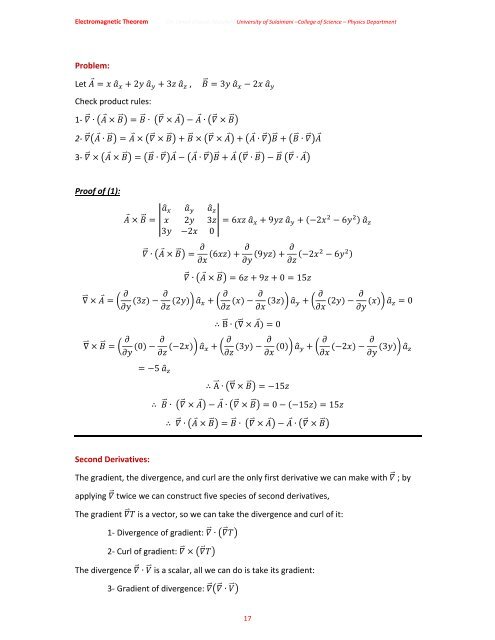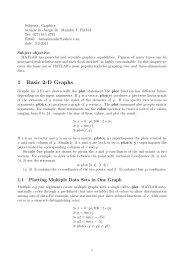Chapter One: Vector Analysis The use of vectors and vector analysis ...
Chapter One: Vector Analysis The use of vectors and vector analysis ...
Chapter One: Vector Analysis The use of vectors and vector analysis ...
You also want an ePaper? Increase the reach of your titles
YUMPU automatically turns print PDFs into web optimized ePapers that Google loves.
Electromagnetic <strong>The</strong>orem<br />
(Dr. Omed Ghareb Abdullah) University <strong>of</strong> Sulaimani –College <strong>of</strong> Science – Physics Department<br />
Problem:<br />
Let 2 3 ,<br />
3 2 <br />
Check product rules:<br />
1‐ ∙ ∙ ∙ <br />
2‐ ∙ ∙ ∙<br />
3‐ ∙ ∙ ∙ ∙<br />
Pro<strong>of</strong> <strong>of</strong> (1):<br />
<br />
2 36 9 2 6 <br />
3 2 0<br />
∙ 6 9 2 6 <br />
∙ 6 9 0 15<br />
3 2 3 2 0<br />
∴B ∙ 0<br />
0 2 3 0 2 3 <br />
5 <br />
∴A ∙ 15<br />
∴ ∙ ∙ 015 15<br />
∴ ∙ ∙ ∙ <br />
Second Derivatives:<br />
<strong>The</strong> gradient, the divergence, <strong>and</strong> curl are the only first derivative we can make with ; by<br />
applying twice we can construct five species <strong>of</strong> second derivatives,<br />
<strong>The</strong> gradient is a <strong>vector</strong>, so we can take the divergence <strong>and</strong> curl <strong>of</strong> it:<br />
1‐ Divergence <strong>of</strong> gradient: ∙<br />
2‐ Curl <strong>of</strong> gradient: <br />
<strong>The</strong> divergence ∙ is a scalar, all we can do is take its gradient:<br />
3‐ Gradient <strong>of</strong> divergence: ∙<br />
17
















